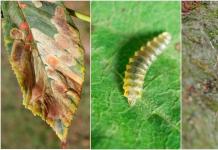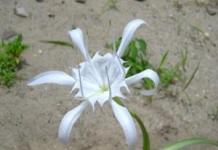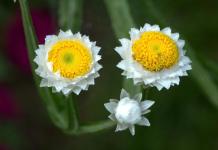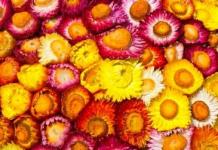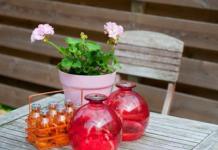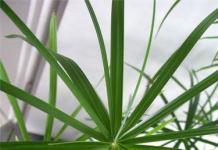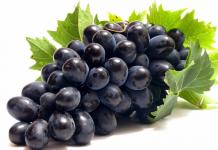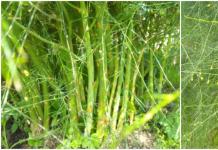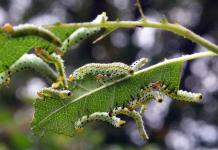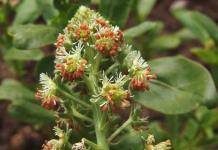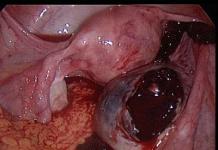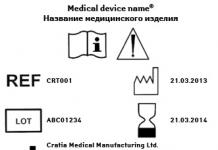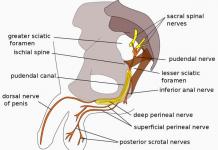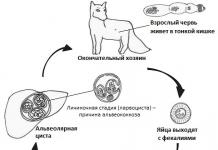One of the most popular fish in our aquariums is the Ramirezi Apistogram. Rumor has it that it was this small, beautiful cichlid that became the prototype of the goldfish from the movie "About the Fisherman and the Fish".
The extraordinary beauty and small size of the fish, the peaceful disposition allow them to be kept both in herbalists and in cichlids, both for professionals and beginners.
Well, let's take a closer look at this amazing inhabitant of our aquariums.
 Latin name: Apistogramma ramirezi also wore Papiliochromis ramirezi, the modern correct Microgeophagus ramirezi.
Latin name: Apistogramma ramirezi also wore Papiliochromis ramirezi, the modern correct Microgeophagus ramirezi.
Russian synonyms: Apistogram Ramirezi, apistogram Ramirez, apistogram Ramirez, apistogram butterfly, chromis butterfly, ramirezki, apistogram ramirezi.
Foreign names: Ramirezi, Ramirezi Dwarf cichlid, Butterfly cichlid Ram cichlid, Sudamerikanischer Schmetterlingsbuntbars, Sommerfuglecichlide.
Detachment, family: Perchids (Perciformes), cichlids, cichlids (Cichlidae).
Comfortable water temperature: 25-30 ° C.
"Acidity" Ph: 6-8.
Hardness dH: does not matter, preferably up to 15 °.
Dilution water: dH up to 10 °; pH 6.5-7.0; temperature 25-27 ° C and above. kH is minimal.
Aggressiveness: not aggressive 10%.
Complexity of content: easy.
Ramirezi apistogram compatibility: although they are cichlids, they are not aggressive. Even small, peaceful fish and even live-bearers are favorably disposed towards. As neighbors, you can recommend: red swordtails, thorns, tetras, neons, zebrafish, all peaceful catfish, gourami and lalius, parrots, other non-aggressive cichlids and even discus and scalars. Chromis butterflies get along with virtually all medium-sized or peaceful fish. Moreover, they are supportive of aquarium plants - they do not pinch, dig or uproot them. Of course, this property allows you to keep ram-cutters even in luxurious herbalists.
Not compatible: Butterfly apistogram is definitely not compatible with large and aggressive fish - cichlids and catfish, piranhas and other aggressors. Not compatible with the entire family of goldfish.
How many live: ramirez apistogram is not an aquarium long-liver and can live for about 4 years in cool water - 25 degrees. And 2-3 years in warm water 27-30 degrees. At the same time, it is worth noting that these fish are thermophilic, they feel good in warm water, which, in fact, allows them to be kept with the same thermophilic fish as discus fish. Oh, here in cold water Ramirezk are uncomfortable, they often start to hurt. According to my own observations, I can say that it is so - just like the apistograms of semolina butterflies))) Warm water is comfortable for these fish and, as you know, is not comfortable for ichthyophthyriosis. You can find out how long other fish live IN THIS ARTICLE!
The minimum volume of the aquarium for the Ramirezi apistogram: from 30 liters, in such an aquarium you can plant a couple + small catfish and medium-sized neighbors. At good conditions content and in large aquariums, they sometimes grow up to 6-7 cm. For information on how many fish can be kept in X liters of an aquarium, see (at the bottom of the article there are links to aquariums of all sizes).
Requirements for the care and maintenance of the Ramirezi apistogram

Necessarily need aeration and filtration, weekly replacement of up to 1/4 of the volume of aquarium water.
It is not necessary to cover the aquarium, the fish do not jump out of the reservoir.
They are not pretentious about lighting, it is desirable that in the aquarium cover, one of the lamps was a special lamp that enhances the color of fish (for example, Marin Glo), with such lighting all the richness of colors in the apistogram will be clearly visible. As aquarium plants any diluent can be recommended from vallisneri to eleocharis parvula.
The design of the aquarium, at your discretion: stones, grottoes, driftwood and other decorations. An open swimming area must be provided in the aquarium. Shelters are not particularly needed.
Ramirez Apistogram Feeding and Diet
Fish are omnivorous and absolutely not whimsical to feed. They are happy to eat dry, live food and substitutes. Like many aquarium inhabitants, they love live food: bloodworms, brine shrimp, bushes, cyclops, daphnia. Food is taken from the surface of the water and in its thickness, the fish do not hesitate to walk along the bottom, collecting the remains of food.
Feeding any aquarium fish should be correct: balanced, varied. This fundamental rule is the key to the successful keeping of any fish, be it guppies or astronotuses. The article talks about this in detail, it outlines the basic principles of the diet and feeding regime of fish.
In this article, we will note the most important thing - feeding the fish should not be monotonous, the diet should include both dry food and live food. In addition, you need to take into account the gastronomic preferences of a particular fish and, depending on this, include in its diet food either with the highest protein content or vice versa with plant ingredients.
Dry food is, of course, a popular and popular food for fish. For example, every hour and everywhere you can find food of the company "Tetra" - the leader of the Russian market on aquarium counters, in fact, the range of food of this company is amazing. In the "gastronomic arsenal" Tetra includes as individual food for a certain type of fish: for goldfish, for cichlids, for loricaria, guppies, labyrinths, arowans, discus, etc. Also, the Tetra company has developed specialized feeds, for example, for enhancing color, fortified or for feeding fry. Detailed information about all Tetra feeds, you can find on the official website of the company -

It should be noted that when buying any dry food, you should pay attention to the date of its manufacture and shelf life, try not to buy food by weight, and also keep the food closed - this will help to avoid the development of pathogenic flora in it.
Live in nature: shallow water bodies of the tropics, subtropics of South America. Venezuela, Colombia and Bolivia.
Description:
The body of the ramirezi is ovoid, flattened laterally, large eyes, terminal mouth. The dorsal fin is long and high.
The general color of the Ramirezi apistogram is blue with a purple tint, the mouth and forehead are red. From the back there are several rows of dark spots, which turn into incomplete transverse stripes. The more the charcoal spot limits the eye.
A bit of history: The Latin specific name for this apistogram was in honor of Manuel Vicente Ramirez, who collected specimens of this species.
Varieties (types) of Ramirezi's apistogram
There is a fairly large number of breeding forms of this dwarf cichlid: a balloon - electric blue - neon, gold, as well as a veil and albino form. Below is a photo of a selection of types of apistograms.





Breeding and sexual characteristics of the Ramirezi apistogram

During spawning, especially males, acquire an intense blue-violet coloration. In the male, the color of the abdomen is orange, and in the female it is crimson. The first rays of the dorsal fin of the male are black and elongated; 2-3 rays of the dorsal fin in the male are usually longer than in the female. In females black spot on the side it is usually framed with paetkas. Males are larger than females. Ramirezi apistograms become sexually mature by 4-6 months, when they reach a length of about 3 cm.
Breeding and spawning of ram-cutters is not difficult, in fact, it is typical for spawning of most cichlov fish. In fact, spawning occurs on its own.
The big challenge in breeding is getting a good pair of breeders. Ramirez's apistogram is characterized by laziness and disgust for offspring, they either eat caviar, or leave it without care and attention. Caused - this is the long-term maintenance of fish at home. Domesticated specimens are lazy and you have to pant really hard to get a caring pair of producers. The rest is not difficult.
Couples are persistent and persist throughout the reproductive age. For spawning, an aquarium of 15 liters or more is usually used, with coarse-grained sand, with thickets of plants and an abundance of flat stone surfaces. The water in the spawning aquarium should be more acidic (by 0.1-0.3 units) and warmer by 1-2 ° C than in common aquarium... The thickness of the water column is about 8-10 centimeters, because in vivo, Ramirezi apistograms spawn in shallow water. It is necessary to provide a weak flow of water.
Spawning is stimulated by daily topping up of fresh soft water.
The female lays a clutch (50-400 eggs) either on a flat, open surface, or on the inner wall of a grotto, cave, etc. After that, both parents begin to take care of the offspring, especially the male. Eggs get over, the dead are destroyed. The masonry can be moved from place to place.


The incubation period of eggs, depending on the water temperature, can be from 45 to 80 hours. Well, then larvae appear, which, due to the yolk sac, feed on their own for 5-7 days. In the first days, the larvae are immobile, then the male begins to move them into the pits.
Interesting video about Ramirezi's apistogram
Apistogram "electrician" is, perhaps, the most common aquarium fish. It is bred by both professional aquarists and amateurs. It has a variety of artificially derived forms, such as veil, neon, blue neon, electric blue, gold and others. This fish is also called a butterfly. The amazingly beautiful blue electrician is the result of the careful work of the sectioners, appeared presumably in 2009. The new brighter forms of Ramirezi are very beautiful, but at the same time they have reduced immunity, and they often get sick. Many sellers use hormones and various injections to make the fish brighter and more attractive before selling. Therefore, when purchasing this fish, you should choose trusted stores.
Quick jump to the article
Description
The fish belong to the dwarf cichlid family. The Electric Blue has a beautiful neon blue body color and a brownish orange head. Their eyes are tinted red with a vertical stroke of black. Many aquarists are delighted with these fish, while others, on the contrary, are sure that the Ramirezi apistogram looks too artificial because of its color. The most bright electric blue look during the spawning and mating season. Females are not inferior to males in beauty and brightness. Males have elongated first rays of fins. It is also worth noting that males are larger than females. Another important distinguishing parameter of males from females of Ramirezi: when growing up, the forehead of males becomes more convex than the forehead of females.

Due to its calm and peaceful nature, the ramirezi apistogram can calmly live in multi-species common aquariums, but you should not keep with them small species of shrimp, tiger, neocaridin, since the cichlid is a small predator, and there will be a blue apistogram to hunt them. It can also be attacked by larger species of fish. During the spawning period, they are more aggressive, but all joints do without severe damage and injury.
Look at the games of the two ramirezi.
Care features
Since the species of the ramirezi apistogram is quite young, not much is known about the features of the content. Suitable for these fish minimum size aquarium from 30 liters. The cost of purchasing an aquarium is 30 liters per pair. It is desirable to keep such a species as the ramirezi apistogram, in a ratio of three females per male, or in flocks, where the quantitative predominance of females is also necessary. Fish love clean water with a small current. Comfortable conditions for fish are as follows:
- temperature 25-32 ° C;
- water hardness 1-14 about, pH = 5.4-7.5;
- good filtration;
- regular water changes up to 20% weekly.
Remember that water must be added in medium-sized portions to avoid sudden changes in water parameters. It is advisable to measure the ammonia content in the water. The choice of filter depends solely on your preferences, both external (preferable) and internal. It is better to stylize the aquarium as a tropical forest reservoir, add alder cones, almond or peat leaves to it. To decorate the bottom, you can use sandy soils. You can also add dense vegetation, driftwood and branches to the aquarium, so you provide shelter for the fish, and this will also contribute to less clarification of relations for the territory. Fish look good on blue and dark backgrounds of the aquarium.
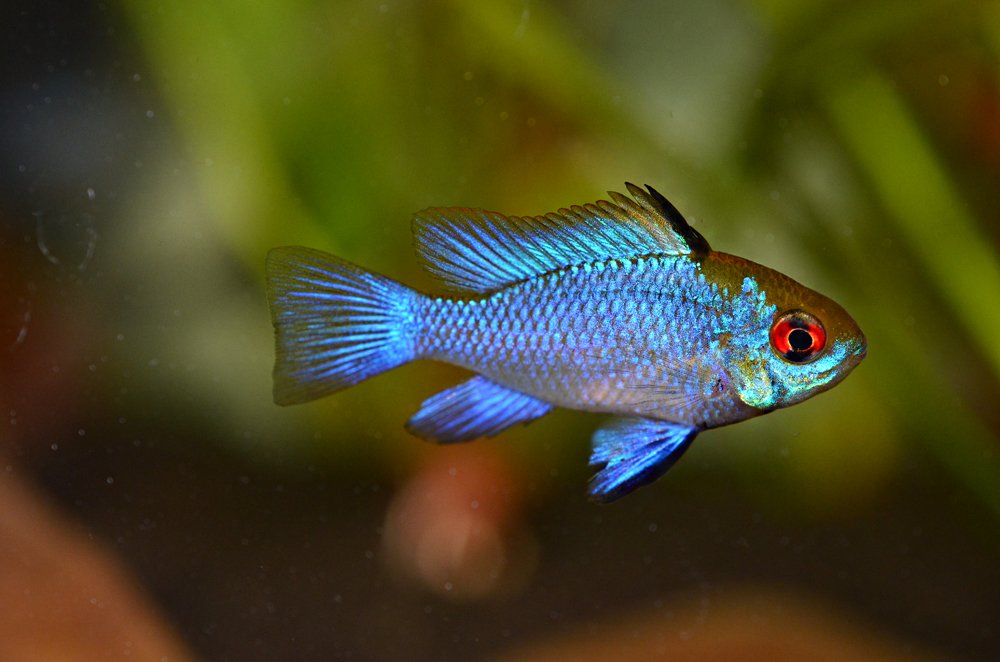

Reproduction and breeding
Fish ripen by the sixth or eighth month, usually by this time they reach three centimeters in length. For spawning, it is necessary to adhere to the specified parameters of the water, it must be soft, warm and sour, or the larvae will not hatch from the eggs. The apistogram blue usually spawns every 10-15 days, the older the fish, the less spawning. The female lays eggs in a dug hole or on a large flat-shaped stone, she often uses for this purpose, large leaves of plants are needed. After some time (several days) fry appear, which must be fed at least four times a day with dust. After five days, the fry can be fed with ciliates, dust and brine shrimp.
Look at the spawning of the ramirezi apistogram.
The ramirezi apistogram grows slowly, at the age of five months it reaches a size of about three centimeters. Coloring fry in the first month of life gray, closer to two months they acquire their color, but not as bright as in adulthood. By what age they acquire their final brightness is unknown. In the process of analytical observation, it was noted that even in individuals from the same brood, the acquisition of their brightness occurred during different time intervals.
The adult blue apistogram feeds on any live food, such as cyclops, brine shrimp, bloodworms, tubifex, and substitutes. It is necessary to feed the fish a couple of times a day in small portions. It is not necessary to overfeed the fish, since in case of overeating, they will float to the surface of the water, and after a short amount of time, they will die. In general, the causes of death of this representative of cichlids have not yet been fully understood. The apistogram of the ramirezi is very sensitive to a sharp change in water in a large number, and if you change the water by more than 20%, the whole flock may die. The average life span of a fish is three years.


Tropical. So you can call the apistogram. This belongs to the cichlid family. It, in turn, is included in the suborder perch. There are almost 2,000 species in the family. 1300 of them are described.
Taking into account the undescribed family of cichlids, it is the third most abundant vertebrate species. Many of them are aquarium ones. This also applies to the apistogram. In nature, it lives in the waters of the Amazon. We will find out whether it is worth moving the apistogram from the river to the home aquarium.
Description of the apistogram
Name apistogram made up of several Latin words and translates as "curved stripe on the side." All 100 species have this. Yes, yes, apistogram is a general name.
In some groups, a dark stripe runs from the eyes to the gill covers, in others it reaches the tail. Sometimes, the line is interrupted, forming from a series of spots. But, the arrangement of the picture is always curvilinear.
A shortened line on his body wears ramirezi apistogram... She, like other members of the group, has an elongated and flat body. The width from the back to the abdomen is impressive, although there are “thin ones” among the apistograms.

In length it reaches 8 centimeters. Female apistogram does not exceed 7 centimeters. The type of ramirezi is called, in the same way, apistogram butterfly... However, this is how all the decorative groups can be called.
They have large, bright fins. Their contours are smooth or torn. In the first case, the blades resemble wings, and in the second -. Birds are also mentioned in a number of names. Let's remember cockatoo. Apistogram has many elongated rays on the dorsal fin. Its outgrowths are like a crest.

In the photo, the apistogram agassitsa
In length fish apistogram cockatoo reaches 12 centimeters. Among the aquarium cichlid species, this is a record. Cockatoo is one of the natural representatives of the group. They also include apistogram agassitsa.

In the photo apistogram borelli
It is distinguished by a tail in the shape of a candle flame. The color of the fin also corresponds to fire. And here borelli apistogram more like the sun, it also lives in its natural environment. The head and breast "shine" with gold.

In the photo apistogram balloon
Closer to orange colors apistogram balloon... even shorter and higher than the ramirezi, it resembles a kind of ball with fins, or an orange. It is not separated by a dark line. The strip runs from the eyes to the mouth. The length of the balloon does not exceed 6 centimeters.
Most different from members of the group apistogram widget... She lives not in, but in rivers. smaller than other apistograms, it grows only up to 5 centimeters. This length is beaten by the widgets' fins.

In the photo, the apistogram of the widget
The dorsal and anal are inclined along the body, go beyond it, that is, end further than the tail. The fins are painted in gray-black tones, which makes the appearance of the widgets dramatic. The body of the fish is silvery blue.
Some apistograms do not occur in nature, they were bred specifically for aquarium maintenance. Breeding, for example, includes an electrician blue. Apistogram This species is bred on the basis of ramirezi, they are distinguished by a neon blue color. The fish heads are orange-red. Is different apistogram electrician and dimensions. The fish of the species is a couple of centimeters smaller than the ramirez.
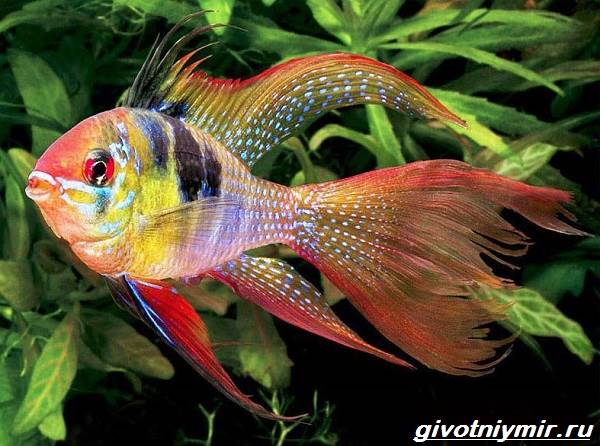
In the photo, a veiled apistogram
Especially colorful of the selection veil apistogram... It is completely iridescent. Dominated by yellow, orange, olive tones. Shades of blue reign among the spots. Flashes of purple are visible on the fins. The latter, like the tail of a fish, are elongated and so thin that they sway in the water like a veil.
Care requirement and content of apistograms
Unlike other cyclides aquarium apistogram maintains ok. The fish of the group do not gnaw algae and do not dig the soil. The exception is cockatoo apistogram... She makes holes in the sand, respectively, the fish needs soft soil.

In the photo apistogram electric blue neon
Apistogram aquariums can be abundantly decorated with driftwood, plants, ceramics. comfortable in such an environment. By the way, it is worth building a filter into it. Appistogram loves clean water.
An imitation of running water is done by adding about 20% of fresh water every day. Its temperature should be about 25 degrees. The acid-base balance is also important. If it exceeds 7.5 units, it will not be comfortable, the death of pets is possible.
The apistogram is also susceptible to the volume of water. A couple needs at least 25 liters. There are types that require all 60. We will talk about exceptions to the rules in a separate chapter. In the meantime, let's discuss the parameters of the aquariums.
The minimum container height for a couple is 30 centimeters. For some apistograms, again, aquariums from 50 centimeters in height are needed. But the lighting is the same for all members of the group.

The waters of tropical rivers are shaded by tree crowns, internal vegetation, and snags. Therefore, at home, the apistogram is content with dim light.
Apistogram nutrition
Despite her appearance, the heroine of the article is not eaten by nectar. Predator apistogram. In nature, representatives of the group eat small,.
Accordingly, outside the will, the apistogram should be given live food. In stores you can find cyclops, daphnia, rotifers or bloodworms. They are frozen or processed into flakes. This is a kind of dry food for.
Spectacular photo of apistograms can be done by feeding a bloodworm. It enhances the color of cyclides. They are, incidentally, susceptible to a number of homemade foods. So, a couple of times a week, chopped lettuce or oatmeal is useful.
Types of apistograms
So, we will consider the types that have not yet been mentioned with a special approach to care. Let's start with macmasters. These are the ones that require at least 60 liters of water for a couple. You can't tell by sight.

In the photo, the apistogram of McMaster
The length of a McMaster is no more than 6 centimeters, usually 5. Babies need roots and stones. In nature, the species settles under the foliage that has fallen to the bottom. Without shelter, the McMaster will not survive even in a 60-liter aquarium.
Panduro apistogram more sensitive than other species to the acid-base balance of water. The critical line is 5. At the same time, the fish, like the McMaster, is "water-bread". For a couple of apistograms, a 100-liter container is needed.

In the photo apistogram panduro
Moreover, the length does not exceed 8 centimeters. Females, and at all, grow only up to 5. Outwardly, representatives of the species are inconspicuous. The fins of the panduro are miniature, as well as the body are painted in grayish tones. Only the caudal fin has a bright orange stripe, and then only in males.
Blue neon - a kind of apistograms, spectacular in appearance, but pampered. sensitive to the slightest deviations from the standards of maintenance. In inexperienced hands, neons die, and therefore are recommended for seasoned aquarists.

In the photo apistogram blue neon
They know, for example, that neons like to live in packs. The composition of the company is also important. Flocks with a predominance of females are selected. Moreover, even with ideal care, the neon apistogram lives no more than 2 years.
Apistogram compatibility with other fish
Aquarists fell in love with not only the appearance apistogram. Buy cichlid fish are sought after because of their peaceful disposition. By the way, apistograms show no interest. However, the cichlids themselves are eaten.
Therefore, they try not to lodge apistograms with large, aggressive predators. However, cockatoo gets along, for example, with. The reason for the peaceful neighborhood is the large size of the parrot-like apistogram. They are afraid to attack such scalars.
The apistogram is settled, in the same way, with rasbora and neons. But borelli and agassitsa are chosen as neighbors of haracin and barbus. The former are distinguished by the presence of an adipose fin, and the latter by a cocky disposition.

However, small members of the family do not get into a fight. Very peaceful, for example, cherry. He is taken as a companion to the apistogram.
Guppies and cockerels become good neighbors for neons, balloons and altispinos. If a ramirezi is floating in the aquarium, you can add peaceful, zebrafish or tournetia to it. The latter, like neons, lead a gregarious lifestyle.
Reproduction and sexual characteristics of apistograms
The breeding period of apistograms is the only time when they are able to attack other inhabitants of the aquarium. worried about the protection of the offspring, they see the enemy to each swim up to the eggs. Some apistograms are so suspicious that they carry caviar in their mouths. Valuable cargo is transferred only to the partner, for example, during a meal.

Some apistograms bury their eggs in the ground. At the same time, the basing of the offspring in the mouth is not excluded. If the parents suspect something was wrong, they suck in the eggs, spitting back into the hole only in a calm atmosphere.
In general, the groups are responsible and loving parents. At first, even apistogram fry... The elders hide them, like caviar, in their mouths. The second option is covering with fins, like wings.
Following the saying “there is a black sheep in the family,” among the apistograms, there were those who lack parental instincts. Ramirezi, for example, eat their offspring without batting an eye. Electric blue are less bloodthirsty, but just as scattered, they do not follow their offspring.
Bolivian apistogram becomes a good parent only in adulthood. The fish starts spawning at the age of 12 months, but as a rule, it eats the first broods. Therefore, for reproduction, aquarists select couples that have seen species.
Breeding apistogram Bolivian starts later than other cichlid species. Most of them are ready for reproduction by 5 months. Females of some species change color during the period of gestation. Ramirezi, for example, turns yellow.

In the photo, Ramirezi's apistogram
The sexual characteristics of apistograms are classic for most. Males are larger, brighter, with pronounced fins. Size and "peacock color" help to show off in front of females, seeking their favor.
In the cold, by the way, it is difficult to melt the hearts of apistograms. During the breeding season, families need to warm up the water to at least 27 degrees.
Apistograms are amazingly beautiful, compatible with many others aquarium fish, do not require large aquariums, have interesting behavior ...
Fashionable fish are the ramirezi apistogramma (chromis butterfly) and other apistograms. |
The most famous of the apistograms is the ramirezi apistogram (Apistogramma ramirezi), about which, without any exaggeration, we can say: this is an aquarium fish for all time!
What is remarkable about the ramirezi apistogram? And here's what. There are many beautiful and very beautiful aquarium fish, and each of us has our own favorites, which we like more than others. But do you remember when and under what circumstances you first saw at least one of your favorite fish?
I only remember about the ramirezi. It was the St. Petersburg (then Leningrad) "Kondrashka" ("bird market"), and I was 12 years old. An unusual fish was sitting in a carrier, all in blue sparkles with a gentle lilac tint - I could not take my eyes off - I did not know what it was called. The seller warned my question:
- Perch butterfly - he answered gravely - five rubles ...
At that time, the amount for a student is too heavy. I never bought a ramirezi. But I remembered ... forever ... I suspect that something similar happened not only to me.
Everyone knows that fashion is changing. In clothing from season to season, and in the aquarium, this happens more slowly. As a rule, the interests of lovers of aquarium fish have time to change significantly in five to ten years. In my memory, the fashion for neons and other small "charatsinok" was replaced by the fashion for viviparous fish, then the fashion for barbs, then South American cichlids became popular, well, and then many people were carried away again by cichlids, but African ones, after which they attracted attention " nano-fish ”(small types of rasbor) and suddenly the fish were overshadowed by shrimps ... Like any fashion - aquarium - is repeated. Now again, barbs are regaining their lost positions ... However, some species of aquarium fish always have their loyal and numerous adherents. But can such fish be called fashionable? Probably yes, because in the end, fashionable is something that many people like, for which there is a demand, and the demand for these fish is constant and quite high.
Apistogramma ramirezi one of these fish. It is enough to look at the photo to understand that there is nothing surprising in its constant popularity. She is indeed extremely beautiful and resembles a bright tropical butterfly. No wonder one of the Russian names for this fish is chromis butterfly .
The birthplace of the ramirezi apistogram is the clear, slowly flowing waters of western Venezuela and Colombia (Orinoco basin), the so-called "llanos". Fish adhere to shallow water, where the water can warm up to 30° C and above. Hence the thermophilicity of the ramirezi. The biotope neighbors of butterfly chromis are the well-known and always fashionable red neons ( Paracheirodon axelrodi), rhodostomus ( Hemigrammus rhodostomus), pristella (Pristella maxillaris), red phantoms (Hyphessobrycon sweglesi) ... And in the aquarium, ramirezi apistograms get along very well with them.
Not all aquarium fish (and even more so cichlids) as tolerant of their neighbors as the ramirezi apistograms and othersdwarf American cichlids. But livability is not the only thingtheir dignity, they are also very beautiful, they are characterized by interestingand, without any exaggeration, meaningful behavior. This is the reason for the eternal popularity in all this. ramirezi.
 |
| Photo 1. Chromis-butterfly (ramirezi apistogram), a young male in war "paint" guards the territory that he considers his own. This is by no means the whole aquarium, but a small area of two square decimeters. But his attention is directed only to the males of his species. Other fish can swim here completely freely. It is true, however, to mention a well-known truth: there are no rules without exceptions - sometimes there are aggressive ramirezi, but rarely. |
As for the correct scientific name for the ramirezi, many copies were broken in heated discussions before it was finally determined. Above, I have given the Latin name traditionally used by aquarists, which was originally given to this fish. Although it is now incorrect from the point of view of modern ichthyology, it is well known to Russian, Czech, German, Hungarian and Polish amateurs. Modern correct - Mikrogeophagus ramirezi , but the fish still managed to vilify the name Papilliochromis ramirezi andMicrogeophagus ramirezi... Taxonomists have been arguing about how to call the "ramirezok" since 1957, and in our time the correctness of the name of the genus "Mikrogeophagus" is still disputed by some researchers. As for the species name, then it was given in honor of the Venezuelan collector-conductor V.M. Ramirez, who played important role in the discovery and capture of the first ramirezi in 1947. Since that time, these wonderful dwarf cichlids have become known in the aquarium hobby under the name "" (Apistoramma Ramirez).
Compatibility of the ramirezi apistogram with other aquarium fish. Breeds, varieties (varieties) and types of apistograms.
In addition to the brilliant appearance, the butterfly chromis also has a number of undoubted advantages. He is not grumpy and is very tolerant of his aquarium neighbors. It does not eat plant leaves and does not carry out large-scale excavation work, as many other South American cichlids do. In a word, this fish will not spoil the appearance of the aquarium and will not be bullied. She will get along well in the company of rasbor, neons and small barbs. In addition, I saw ramirezi apistograms in the same aquarium with irises, scalars, cockerels, and even together with clumsy veiled male guppies. These last combinations, perhaps, will seem controversial to many, but, nevertheless, they are quite acceptable, because all the fish in these communities felt great(see also "" and ""). So the last word in resolving the issue " with whom you can keep the ramirezi apistogram together"remains with the aquarist himself, it is only important to avoid the neighborhood of large and aggressive fish. In addition, fish that prefer to live in cold water will also not be a suitable company for ramirezi, because all apistograms are thermophilic. important point: An aquarium with ramirezi should not be, as these fish are sensitive to water pollution and, in addition, will lose the fight for food to more nimble neighbors in the aquarium.
In one aquarium, you can keep several types of apistograms and they, in most cases, get along with each other. But the aquarium for the apistogram community should also be densely planted with plants, and its living space should be increased by caves (broken ceramics and pipes) and small snags. But for one pair of "ramirezok", a small capacity of 20 liters will be enough.
 |
| Photo 2. Above in this photo is the butterfly apistogram aka "ramirezi" (Mikrogeophagus ramirezi), and below the fish, which, according to modern classification, are really called apistograms. These are two conflicting male cockatoo apistograms (Apistogramma cacatuoides). |
 |
| Photo 3. Another apistogram: Borell's apistogram (Apistogramma borellii). Perhaps she is the most unpretentious of the apistograms. |
 |
| Photo 4. ... and one more - the Agassits apistogram (Apistogramma agassizii ). |
 |
| Photo 5. In a fairly spacious aquarium with numerous shelters at the bottom, apistograms and microgeophagus (ramirezi) can form a variegated community, which will be very interesting to observe. |
 |
| Photo 6. This is a fragment of a small 20 liter aquarium. How many fish can you put there? And if much is not possible, will there be anything interesting to observe? Here is an example where all the fish get along peacefully with each other, and the owner can admire the variety of shapes and colors of different species. In this aquarium live: a pair of ramirezi apistograms (Mikrogeophagus ramirezi), a pair of wedge-spotted rasbor (Trigonostigma heteromorpha ), a flock (4 pcs.) of cherry barbs (Puntius titteya ), a pair of black barbs (Pethia nigrofasciata ), there are also a couple of honey gouramis (Trichogaster chuna ) and two ototsinklus (Otocinclus sp. ). In addition to fish, two dwarf frogs live in this aquarium (Hymenochirus boettgeri ), they are still small, they are afraid of everything and hide under the balls of cladophores. Note that novice aquarists should not repeat this without gaining experience. First you need to master the correct techniques for operating smallhomemade and to ensure that they are stable and at zero level, and then get used to changing the water at such a frequency that the content in the water stably remains within acceptable limits. And having learned all this, you can take on the creation of complex aquarium communities in small volumes. |
 |
| Photo 7. Apistograms of ramirezi and discus. it good combination... Ramirezki liven up an overly sedate discus jar. Did you see them? They are in the lower right corner. It can be noted that at the bottom of the aquarium, except for driftwood, there are practically no shelters, therefore, surrounded by large fish, small butterfly chromis do not feel very comfortable, so they huddled in a corner. Ramirezis need a complex space with shelters, then they begin to behave confidently and naturally. The temperature range at which it is possible to contain butterfly chromis is slightly shifted to the warm water side and is 25-31° C. This makes them good companions for discus, and they can bring a pleasant revival to the calm society of the sometimes overly brooding "kings of the aquarium." |
Usually in pet stores they sell young apistograms with a body length of 1.5 - 2 cm.Of course, once in suitable conditions, the fish will grow up. Aquarists are usually interested in: how much? It is difficult to give a definite answer. The body length of an adult ramirezi apistogram can vary over a very wide range. Already adult chromis-butterflies in small aquariums, as a rule, do not exceed 3 - 3.5 cm, and in large containers they can reach 6. Thus, the size of fish strongly depends on the size of the aquarium (the larger it is, the larger apistograms), but the quality of feed and chemical composition water, and heredity, of course. Currently, there are many breeding lines of ramirezi apistograms, differing in size and color.All the same can be said about other types of apistograms.
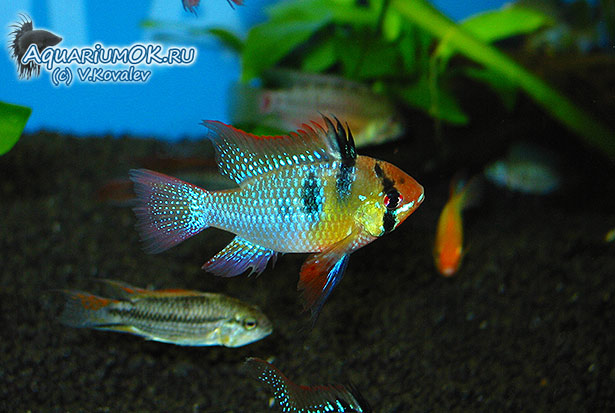 |
| Photo 8. Large male with a predominance of blue color - blue ramirezi. A fish of a strong constitution, high-bodied, but not a "balloon" (for a photo of the ramresi of cylinders, see below) - this is a distinctive feature of Israeli breeding apistograms. Below you can see a rather emaciated fish - a cockatoo apistogram, which is sick with hexomitosis. Unfortunately, this disease is extremely common, and for apistograms it poses more than a real danger. You can read about how to treat apistogram for hexamitosis in special article. Another unpleasant disease that apistograms are prone to is. |
 |
| Photo 9. In the foreground is a selective xantoric (golden) formchromis butterfly. The fish lacks black pigment on the body,but as much red and blue as you like! |
 |
| Photo 10. Fashionable nowadays ramirezi apistograms with a shortened high body - a "balloon" shape. |

|
| Photo 11. Apistogram of ramirezi "electric blue" (Mikrogeophagus ramirezi var. "Electric Blue "). This is also a very popular version of the ramirezi apistogram. These fish are very tender, they are not suitable for beginners. |
 |
| Photo 12. Very fashionable nowadays ramirezi apistograms with a strongly shortened body shape - "balloons", they also have a mega-popular color - "electric blue", and this color is superimposed on top of gold, giving a new variation -Golden electric blue butterfly cichlid that is, it's just mega-fashionable fish. On the left is the female, on the right is the male. Males in the ramirezi apistogram are larger than females, the third hard ray of the dorsal fin is higher than the rest, and often they also have an elongated-pointed end of the dorsal fin. Females are generally rounder, which can be seen even in the "balloons". |
 |
| Photo 12. Another type of apistogram is the Bolivian butterfly (Mikrogeophagus altispinosus ). Bolivians are tougher than ramirezok, they are relatively unpretentious. It is interesting that these fish spawn more readily in the presence of small characin or viviparous fish. Apparently, the presence of calmly swimming, but not dangerous fish in the aquarium is excellent.anti-stress factor... The couple quarrels less while courting the masonry, if there is an external enemy (it's nice that he is also not scary ...). It is much easier for fish to be friends against someone than to fight with each other. In the photo there is a male. |
Feeding apistograms.
Chromis-butterflies willingly eat all types of food, but the diet should be varied. It is impossible from month to month to offer fish only the contents of the same, albeit very expensive and beautiful, branded jar. From time to time it is worth giving ice cream bloodworms or cyclops, live brine shrimp or specially processed (decapsulated). All this, except for live brine shrimp, can now be bought at pet stores, at the Bird Market or in the aquarium online store. And those who like to cook on their own can cook for their fish. In addition, in ornamental fish farming, a great variety of culinary recipes ... In any case, food should not be given in large excess and should not spoil the aquarium water. However, it is not only acceptable, but also desirable for some feed to fall to the bottom. Ramirezi and other apistograms are prone to a bottom lifestyle and willingly seek out various delicacies at the bottom, carefully examining each pebble. There is no need to worry that some of the crumbs will remain uneaten and rot. But it is unacceptable to pour dry food into the aquarium with spoons. TO ammonia, nitrites and nitrates and did an analysis of the water, then they would cease to be surprised.
 |
| Photo 13. Butterfly apistogram (male) is very attentively looking for food at the bottom. He will pick up every last crumb. But he does not like to shove with other fish at the feeder. Other apistograms will not do this either. |
 |
| Photo 14. Two young females of the butterfly chromis (they differ from the male in a more pronounced and crimson abdomen) collect food from the bottom. Firefly tetras (Hemigrammus erythrozonus) are in a hurry to take part in the carve-up of prey. The apistogram and small haracin fish community can long time sustainably exist in the aquarium. These fish require almost the same conditions of detention and they do not offend each other at all. |
|
Video is not visible, most likely your browser does not support HTML5 video |
| Video 1. Ramirezi apistograms prefer to collect food from the bottom of the aquarium. Therefore, it is perfectly acceptable for the food to lie on the bottom for about 15 minutes before it is completely eaten. These should be high quality pellets. Granular discus food is also good. |
Conditions for keeping and breeding apistograms.
Apistograms love clean, oxygenated water with low water. In muddy water with a high organic matter content, they will quickly die. This is why an apistogram aquarium must be equipped with a good filter. Installation is also desirable. Aquarium water parameters such as hardness and (pH) are not very important for apistograms. They can live in soft, slightly acidic water (this is the best option) and in water of moderate hardness. The pH can be slightly acidic, neutral and slightly alkaline. But if you want to breed these fish, then only soft, slightly acidic water is suitable for this (pH = 6.2 - 6.8; KH = 0.5 - 2.0).
As I already mentioned, the temperature range at which butterfly chromis can be kept is slightly shifted towards the warm water side: 25-31°
C. This makes them good companions for discus, and they can bring a pleasant revival to the calm society of the sometimes overly brooding "kings of the aquarium." When keeping apistograms together with small characin fish and rasbora, the water temperature in the aquarium should be 25°
C. Temperature affects the lifespan of apistograms: about 4 years at 25
° C and only 2 years at 30° C.
Breeding Ramirez's chromis, and other apistograms, too, is not so easy. Like the rest of the cichlid fish, the heroes of our story form stable married couples and must diligently look after caviar and fry. But this is not always done. Most often they eat caviar, less often they leave it without parental care. The masonry, abandoned to the mercy of fate, will inevitably perish. Over the long years of being kept in captivity, many of these fish have lost their parental instinct, so it is rather difficult to find a friendly pair capable of consistently caring for the offspring. But if you manage to do this, you will have something to watch. Family life American cichlids are striking in their intelligent organization and high intensity of passions. Each fish has its own special character and easily recognizable demeanor. Apistograms select dead eggs from the clutch, periodically transfer their offspring from place to place, protect eggs and larvae from enemies, which will be considered all other fish living in this aquarium. During spawning, they can become aggressive and strongly pat their smaller neighbors or get nervous and eat caviar (the latter happens incomparably more often). That is why, for breeding fish, it is better to plant them in a separate aquarium with specially prepared soft, slightly acidic water with a small addition of infusion of oak leaves or leaves. Best of all, apistograms lay their eggs on a slightly concave ceramic shard and in nooks bounded by the edges of the stones.
 |
| Photo 15. Ready to spawn withApistogram frame: the arrow points to an enlarged "ovipositor" (genital papilla). Immediately before spawning, the genital papilla in the female is very easy to spot. This is where it is necessary to provide a pair of apistograms with suitable conditions for spawning. Other features ramirezi apistogram females: rounded crimson tummy, third ray of the dorsal fin not higher than the nearest subsequent ones. |
 |
| Photo 16. The female Apistogram Agassitsa guards the clutch (arrow). Dexterous and curiouscozuatis barbs (Oreichthys cosuatis) it drives away quite successfully. Click on the photo to enlarge. |
 |
| Photo 17. Oval light eggs are what attracts other fish to the crevice between the stones. It is almost impossible to save clutches in a common aquarium. In the end, the couple was unable to repulse the attack of the tiger battle. |
Here I will finish my story about apistograms. Watching these wonderful fish in your aquarium, you will learn a lot more interesting things. And finally, I want to wish all aquarists to get as much pleasure from their pets as possible, whether they are in fashion nowadays or not, the main thing is that you like them yourself, and they, in turn, like living in your aquarium!
*** Actually, not only American ... African pelvicachromis and chemichromis are not at all worse. But the behavior, especially of chemichromis, is much sharper. Although ... it all depends on the type of fish.




